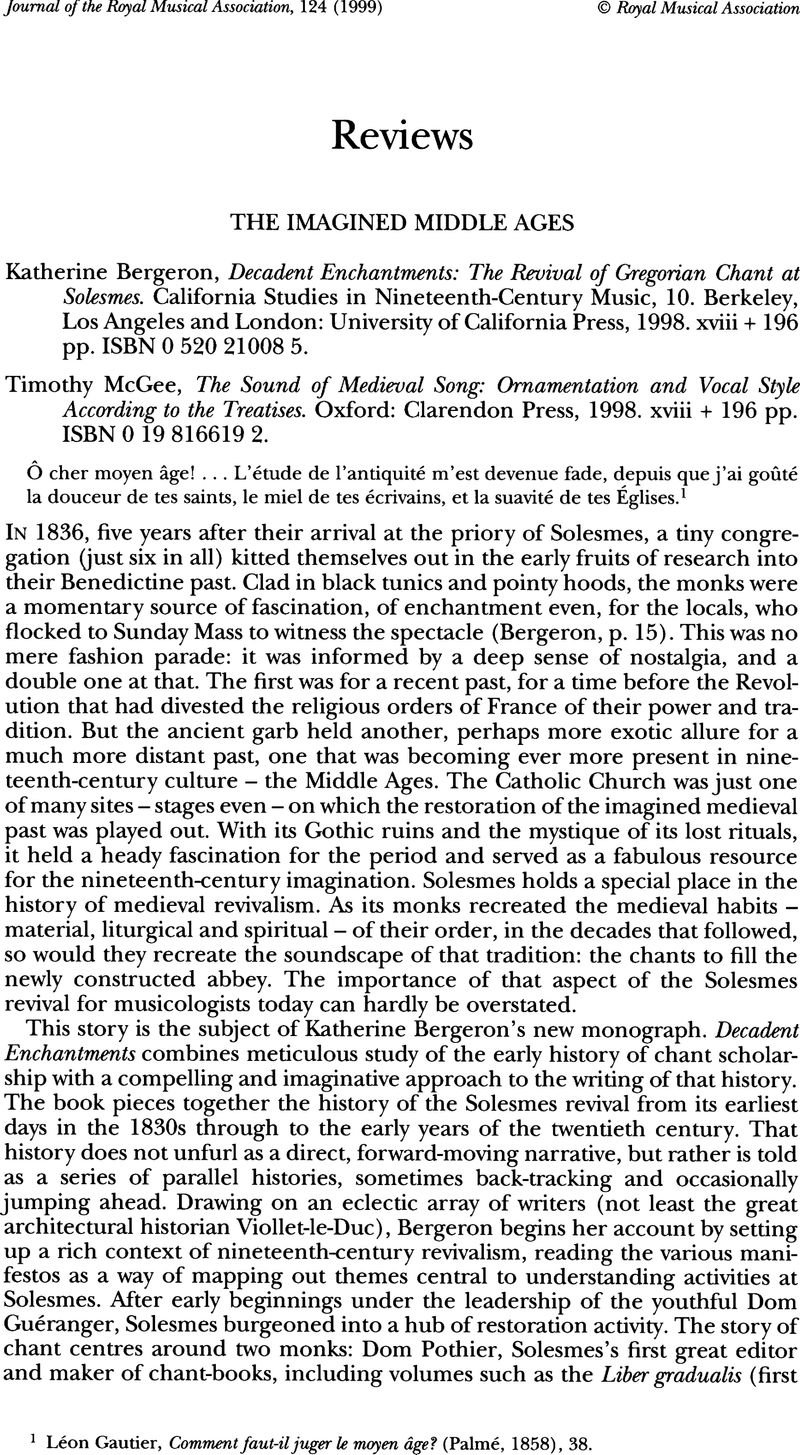No CrossRef data available.
Article contents
The Imagined Middle Ages
Review products
Published online by Cambridge University Press: 13 January 2020
Abstract

- Type
- Reviews
- Information
- Copyright
- Copyright © Royal Musical Association, 1999
References
1 Gautier, Léon, Comment faut-il juger le moyen âge? (Palmé, 1858), 38.Google Scholar
2 Several recent studies take this approach, the most contentious being Bernard Cerquiglini's collection of essays on the nineteenth-century Parisian schools of philology, Éloge de la variante: Histoire critique de la philologie (Paris, 1989). Other key publications in this area include The New Medievalism, ed. Marina Brownlee, Kevin Brownlee and Stephen Nichols (Baltimore, 1991); The Future of the Middle Ages: Medieval Literature in the 1990s, ed. William Paden (Gainesville, FL, 1994); and Medievalism and the Modernist Temper, ed. Howard Bloch and Stephen Nichols (Baltimore and London, 1996). For a recent summary of this aspect of medieval studies, see Howard Bloch and Stephen Nichols, ‘Introduction’, Medievalism and the Modernist Temper, 2–6.Google Scholar
3 Huit chants héroïques de l'ancienne France, XII-XVIIIe siècles, poèmes et musiques recueillis et publiés par M. Aubry, ed. Pierre Aubry with a preface by Gaston Paris (Paris, 1896).Google Scholar
4 For recent accounts of Gaston Paris's contributions to the study of Old French, see Hans Gumbrecht, ‘“Un souffle d'Allemagne ayant passe”: Friedrich Diez, Gaston Paris and the Genesis of National Philologies’, Romance Philology, 40 (1986), 1–37; Michael Camille, ‘Philological Iconoclasm: Edition and Image in the Vie de Saint Alexis’, Medievalism and the Modernist Temper, ed. Bloch and Nichols, 371–401; and David Hult, ‘Gaston Paris and the Invention of Courtly Love’, ibid., 192–224.Google Scholar
5 Paris, Gaston, Histoire poétique de Charlemagne (Paris, 1865), viii.Google Scholar
6 La vie de Saint Alexis: Poème du Xle siècle et renouvellements des Xlle, XlIIe et XTVe siècles, ed. Paris, Gaston, Bibliothèque de l'Ecole Pratique des Hautes Études, Sciences Philologiques et Historiques, 7 (Paris, 1872).Google Scholar
7 Paris, Gaston, ‘Le Roman de Fauvel’, Histoire littéraire de la France, 32 (1898), 109-53.Google Scholar
8 Camille, Michael, Mirror in Parchment: The Luttrell Psalter and the Making of Medieval England (London, 1998).Google Scholar
9 Ibid., 12.Google Scholar
10 Details of this later history of the Psalter are given ibid., 15–48.Google Scholar
11 Jeffrey, Peter, Re-envisioning Past Musical Cultures: Ethnomusicology in the Study of Gregmian Chant (Chicago and London, 1992), 120.Google Scholar
12 Donington, Robert, Baroque Music: Style and Performance - A Handbook (London, 1982).Google Scholar
13 Tanay, Dorit, ‘Music in the Age of Ockham: The Interrelations between Music, Mathematics and Philosophy in the Fourteenth Century’ (Ph.D. dissertation, University of California at Berkeley, 1989).Google Scholar
14 Maria, Anna Berger, Busse, Mensuration and Proportion Signs: Origins and Evolution (Oxford, 1993).Google Scholar
15 Page, Christopher, ‘Johannes de Grocheio on Secular Music: A Corrected Text and a New Translation’, Plainsong and Medieval Music, 2 (1993), 17–41; idem, ‘A Treatise on Musicians from? c. 1400: The Tractatulus de differentiis et gradibus cantorum by Arnulf de St Ghislain’, Journal of the Royal Musical Association, 117 (1992), 1-21; The Summa Musicae: A Thirteenth-Century Manual for Singers, ed. and trans. Christopher Page (Cambridge, 1991).Google Scholar
16 Page, Christopher, Discarding Images: Reflections of Music and Culture in Medieval France (Oxford, 1993), 81-4, includes a detailed account of the etymology of ‘litterati’; see also Page, ‘Johannes de Grocheio on Secular Music’, 36, n. 72.Google Scholar
17 Page, , ‘A Treatise on Musicians’, 18, n. i.Google Scholar


